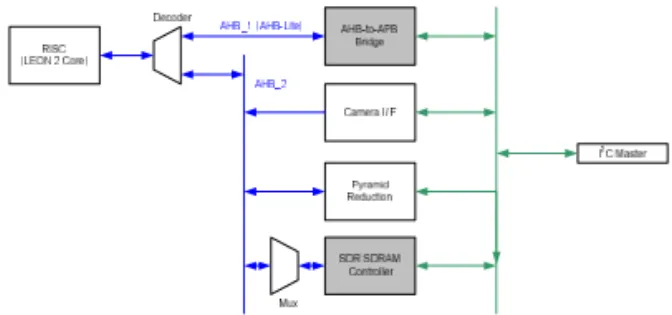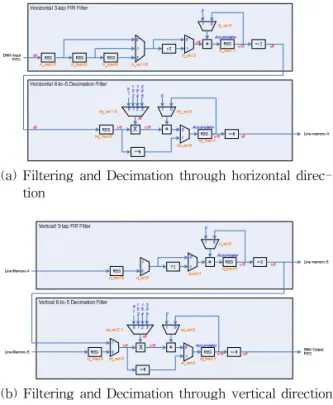1. INTRODUCTION
The Scale Invariant Feature Transform, or SIFT algorithm, has rapidly been adopted in the machine vision community as the “best-in-class” standard for feature detection and matching. Feature de- tection has a variety of applications in image proc- essing across many domains, from object recog- nition and tracking in robotics to create photo mo- saics in consumer photography applications [1].
However, since SIFT algorithm involves an in- tensive time-consuming module, the Gaussian pyramid [2], current SIFT software implementa- tions typically involve the use of a high power, general-purpose processor to achieve less-than- real-time performance. However, for many em- bedded applications, this is an unacceptable sol- ution. A computing power of embedded processors is much less powerful than that of desktop or lap- top computers. In addition, almost of current em- bedded processors do not have hardware support- ing floating point computation in order to reduce power consumption and chip size [3]. With a hard- ware implementation of the Gaussian pyramid, the
full power of the SIFT algorithm could be available to mobile sensing platforms without the overhead of a separate, high power processor [1].
A few hardware implementations [1, 4, 5, 6, 7]
were proposed for constructing image pyramids. In [1], they implemented the hardware for generating a variation of Gaussian pyramid. However, the im- plemented hardware accepts fixed sized images so that it can be applied to various applications. In [4], they implemented image pyramid generation unit (IPGU) as a part of face detection hardware.
However, since it only performed size reductions without convolution operations, the aliasing prob- lem can be occurred. In [5], they implemented the hardware that generates 2-levels pyramid. In [6], they implemented pipeline schemed hardware for construction of the Gaussian pyramid. In [7], they designed the 3-levels pyramid generation hard- ware embedded into their stereo matching hard- ware system.
Although many implementations were proposed, they have common problems to be used for embed- ding various applications. For embedding into var- ious devices, the hardware implementation has a
Design and Implementation of Image-Pyramid
Bongkyu Lee
†ABSTRACT
This paper presents a System-On-a-chip for embedded image processing applications that need Gaussian Pyramid structure. The system is fully implemented into Field-Programmable Gate Array (FPGA) based on the prototyping platform. The SoC consists of embedded processor core and a hardware accelerator for Gaussian Pyramid construction. The performance of the implementation is benchmarked against software implementations on different platforms.
Key words: Image Pyramid, Multi-resolution, Visual System, Gaussian Pyramid
※ Corresponding Author : Bongkyu Lee, Address: (690- 756) Jejudaehak-ro 120, Jeju-si, Jeju-Do, TEL : +82-64- 754-3593, FAX : +82-64-725-2579, E-mail : bklee@jeju- nu.ac.kr
Receipt date : May 9, 2016, Revision date : June 4, 2016
Approval date : July 11, 2016
†
Dept. of Computer&Statistics, Jeju National University
※ This research was supported by the 2015 scientific
promotion program funded by Jeju National University
component for connecting to processors, memory systems and even external devices embedded into applications. Second, it is needed to accept various sized images, since cameras attached to mobile sensing devices have several resolutions, such as 320×240, 640×480 or 160×120. Finally it is also needed that the Gaussian pyramid supports differ- ent levels of pyramids according to the applications.
In this paper, we describe the design and im- plementation of a Gaussian pyramid processor for various embedded image processing applications.
The implementation steps are as follow. First, we designed and implemented the prototyping plat- form based on a Field Programmable Gate Array (FPGA). The platform was used for testing and debugging the target SoC architecture in the regis- ter transfer level. We evaluated the performance of the implemented SoC in the register transfer level using the platform.
The remainder of the paper is as follows. In Section II, we review the computation process of Gaussian pyramid. Section III explains the pro- posed Gaussian pyramid processor. The emulation result is presented in Section IV, and final dis- cussions are given in Section V.
2. THE GAUSSIAN PYRAMID
Gaussian pyramid consists of reduced copies of an image, where the size of an image decreases in a factor s from one level to the next, and a low-pass filter is convolved with level for avoiding aliasing problems [8]. Gaussian pyramid con- struction can be described as follows. Suppose the image is represented initially by the array
which contains C column and R rows of pixel. Pyramid level 1 contains image
which is reduced and low-pass filtered version of
. The level-to-level computation is performed by the function REDUCE [8].
(1)
which means, for levels and pixels
≤
≤
,


